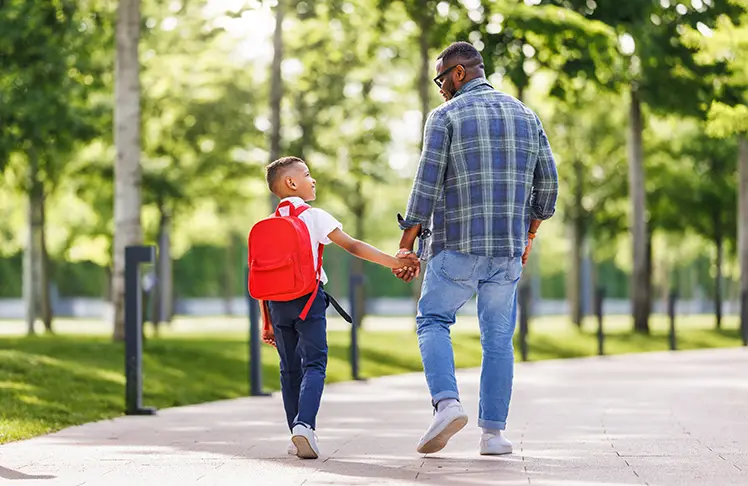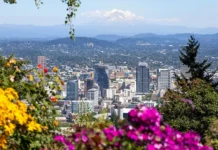
As students across Portland prepare to return to school, the Portland Bureau of Transportation (PBOT) is urging residents to travel with heightened caution. Thousands of children and families will soon be walking, biking, rolling, and riding public transit—making streets busier and the need for safety more critical than ever.
“Our youngest residents are heading back to school,” said Mayor Keith Wilson. “As is the Portland way, thousands will be walking, biking, and rolling to get there, just like I did with my kids. It’s up to all of us to watch out for our students and keep them safe.”
“Back-to-school season is a reminder that safe, welcoming streets depend on all of us,” added Priya Dhanapal, Deputy City Administrator for Public Works. “Across our Public Works bureaus, we’re working together to make neighborhoods healthier and safer so kids can walk, bike, and roll to school with confidence.”
PBOT Director Millicent Williams emphasized the city’s commitment to student mobility and safety.
“One of the best parts of my job is seeing the joy on the faces of Portland students as they walk and roll to school,” said Williams. “PBOT is committed to making investments that support student safety and mobility. We appreciate Portlanders’ support of Fixing Our Streets, which has already funded 350 completed projects near schools.”
PBOT reminds drivers to be vigilant throughout the city, not just near school zones. With over 120 schools in Portland, most people pass a school or a student travel route every half mile. Crashes are most common between 3 and 7 p.m., coinciding with school dismissals and after-school programs.
Thanks to voter-approved funding, PBOT completed 55 improvement projects near schools during the 2024–25 school year, including:
• 25 crossing enhancements (e.g., curb ramps, crosswalks, signals)
• 20 speed-related projects (e.g., speed bumps, reduced limits, reader boards)
• 10 walkway improvements (e.g., sidewalks and paths)
These upgrades are funded through Portland’s 10-cent gas tax and heavy vehicle use tax—renewed by voters in 2024 for a third time under the Fixing Our Streets program. Since 2016, this program has enabled the completion of 350 school-area projects, with another 100 in progress.
More improvements are on the way for 2025–26. Current or upcoming construction projects include safer crossings on NE Killingsworth and N Charleston Avenue, new pathways and crosswalks in neighborhoods like Roseway, Parkrose Heights, Laurelhurst, and South Tabor, and a new multi-use pathway on NE 106th Avenue.
PBOT is also expanding its vision clearance initiative—or “daylighting”—to increase intersection visibility by removing parking spaces within 20 feet of crossings. Over 200 intersections will be updated using Fixing Our Streets funds and a one-time 2024 General Fund investment. Yellow curb markings, “no parking” signs, and bilingual educational lawn signage will be installed near participating schools.
To promote biking to school, PBOT’s Safe Routes to School program is partnering with Bike Bus PDX on a pilot wayfinding project. Signage and pavement markings will guide families on safe neighborhood greenways and raise awareness about organized bike bus routes.
Students and families are encouraged to prepare for fall walk-and-roll events like International Walk + Roll to School Day on Wednesday, Oct. 8, and Ruby Bridges Walk to School Day on Friday, Nov. 14. Practicing routes in advance helps families find the safest ways to school while building healthy, climate-conscious habits.
PBOT encourages caregivers to form walking school buses or bike buses, where families travel together and pick up others along the way. Those who usually drive can try a “park-and-walk” by parking a few blocks from school and walking the rest of the way—saving on gas and giving students a bit of exercise before class.
Walking or biking to school offers mental and physical benefits. “Morning activity increases brain activity,” PBOT notes, helping students arrive focused and energized. More than 25 schools already host bike buses, with more joining each year.
Safety remains paramount. In 2024, speeding contributed to at least 48% of Portland traffic deaths. A person hit by a vehicle traveling at 20 mph is four times more likely to survive than one struck at 40 mph. To reach its Vision Zero goal of eliminating traffic deaths and serious injuries, PBOT is investing in infrastructure improvements, reducing speed limits, educating the public, and working with the Portland Police Bureau to enforce traffic laws.
Resources for planning safe school commutes are available on PBOT’s Safe Routes to School Back to School webpage.















